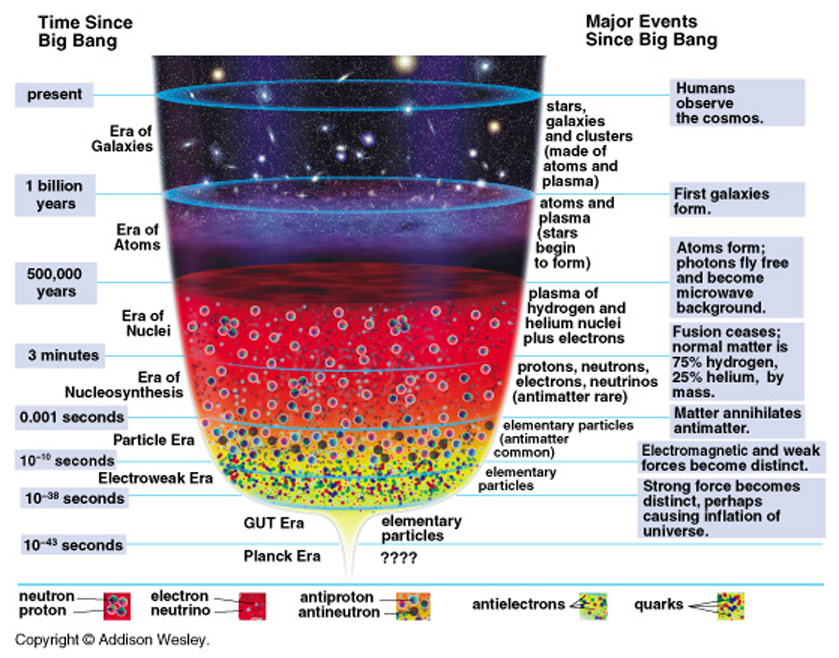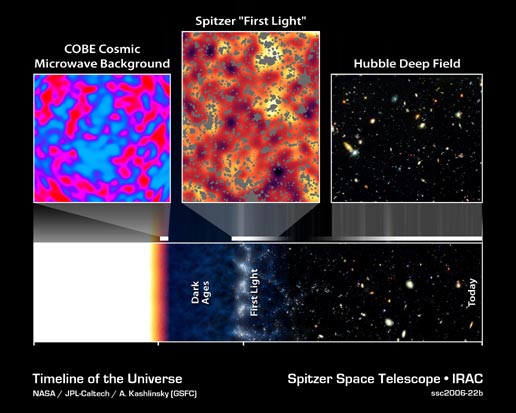
| Palaeos: |  |
Cosmos |
| COSMOS | Cosmology |

The Cosmological Timescale: The familiar bell-shaped cosmological timescale, giving the history of the universe from the Big Bang to now, in logarithmic or quasi-logarithmic increments, is as familiar to science geeks as the geological timescale, the periodic table of elements, and the evolutionary tree of life. Like the geological timescale, and perhaps inspired by it, time is divided into arbitrary units, here also called eras or epochs, although the respective terms are not homologous (uh, I mean synonymous). Unlike the geological timescale, which by convention starts at the bottom and moves up (as a result of its origin in 19th century geology and stratigraphy), the cosmological timescale has no formal orientation. Cosmological diagrams on these pages variously progress from top to bottom, bottom to top (as in the above diagram), or sideways. This timescale is actually the result of a century of physics, astronomy, and cosmological research, as explained in the following history of cosmology overview MAK110726
History of Modern cosmology: adapted from Wikipedia:
Modern cosmology developed along tandem tracks of theory and observation. In 1915, Albert Einstein formulated his theory of general relativity, which provided a unified description of gravity as a geometric property of space and time. At the time, physicists believed in a perfectly static universe that had no beginning or end.
In the 1910s, Vesto Slipher (and later Carl Wilhelm Wirtz) interpreted the red shift of spiral nebulae as a Doppler shift that indicated they were receding from Earth. However, it is difficult to determine the distance to astronomical objects. One way is to compare the physical size of an object to its angular size, but a physical size must be assumed to do this. Another method is to measure the brightness of an object and assume an intrinsic luminosity, from which the distance may be determined using the inverse square law. Due to the difficulty of using these methods, they did not realize that the nebulae were actually galaxies outside our own Milky Way, nor did they speculate about the cosmological implications. In 1927, the Belgian Roman Catholic priest Georges Lemaître proposed, on the basis of the recession of spiral nebulae, that the universe began with the "explosion" of a "primeval atom"—which was later called the Big Bang. In 1929, Edwin Hubble provided an observational basis for Lemaître's theory. Hubble showed that the spiral nebulae were galaxies by determining their distances using measurements of the brightness of Cepheid variable stars. He discovered a relationship between the redshift of a galaxy and its distance. He interpreted this as evidence that the galaxies are receding from Earth in every direction at speeds directly proportional to their distance. This fact is now known as Hubble's law.
There were two primary explanations put forth for the expansion of the universe. One was Lemaître's Big Bang theory, advocated and developed by George Gamow. The other possibility was Fred Hoyle's steady state model in which new matter would be created as the galaxies moved away from each other. In this model, the universe is roughly the same at any point in time. For a number of years the support for these theories was evenly divided. However, the observational evidence began to support the idea that the universe evolved from a hot dense state. The discovery of the cosmic microwave background in 1965 lent strong support to the Big Bang model, and since the precise measurements of the cosmic microwave background by the Cosmic Background Explorer in the early 1990s, few cosmologists have seriously proposed other theories of the origin and evolution of the cosmos. One consequence of this is that in standard general relativity, the universe began with a singularity, as demonstrated by Stephen Hawking and Roger Penrose in the 1960s.
In 1981 Alan Guth proposes the inflationary Big Bang universe as a possible solution to the classic conundrum of the Big Bang cosmology: why does the universe appear flat, homogeneous (uniform) and isotropic (the same in every direction) in accordance with the cosmological principle when one would expect, on the basis of the physics of the Big Bang, a highly curved, heterogeneous universe? While not perfect, the Inflation theory solves these problems better than the alternatives.
Link: Creation of a Cosmology: Big Bang Theory
Current Big Bang cosmology: To the original basic idea have been added in the last three decades further discoveries, such as the cosmic dark ages and several phases of reionisation.

Timeline of the Universe, highlighting some major watersheds in the history of the cosmos. Diagram from From Brief History of the Universe Image credit: NASA/JPL-Caltech. This timeline integrates three different observations: Cosmic Background Microwave Radiation (NASA's Cosmic Background Explorer and Wilkinson Anisotropy Microwave Probe) , First Light (NASA's Spitzer Space Telescope), and First Galaxies (Hubble Deep Field and Ultra Deep Field)
Huge advances in Big Bang cosmology were made in the late 1990s and the early 21st century as a result of major advances in telescope technology in combination with large amounts of satellite data, such as that from COBE and the Hubble Space Telescope. In 2003, NASA's WMAP took more detailed pictures of the universe by means of the cosmic microwave background radiation. The images can be interpreted to indicate that the universe is 13.7 billion years old (within one percent error) and that the Lambda-CDM model and the inflationary theory are correct. No other cosmological theory can yet explain such a wide range of observed parameters, from the ratio of the elemental abundances in the early Universe to the structure of the cosmic microwave background, the observed higher abundance of active galactic nuclei in the early Universe and the observed masses of clusters of galaxies. (Wikipedia)
As for cosmic inflation, Guth's original model is now considered obsolete, and various other versions of inflation have since been proposed, as well as criticism and alternatives.
A few links: Big Bang Cosmology Primer (basic intro); A Brief History of the Universe for a more detailed synoptic coverage; Big Bang - Wikipedia (as expected, detailed coverage, lots of references, but the usual wiki-editing unevenness and repetition problems); Science and Reason: The Big Bang, WMAP Big Bang Theory.
| Page Back | Page Top | Unit Home: Cosmos | Page Next |
content by MAK110729, quotes from Wikipedia. Edited RFVS111026